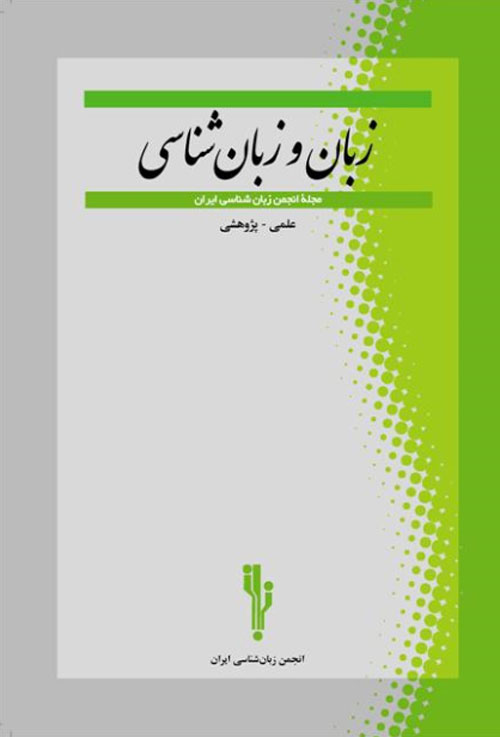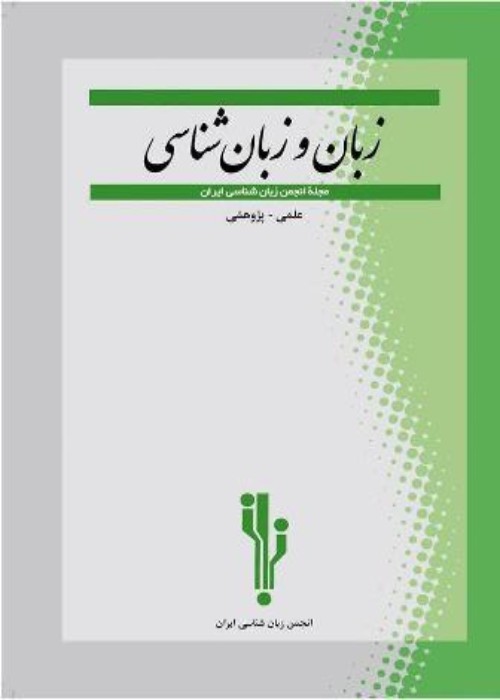فهرست مطالب

نشریه زبان و زبان شناسی
پیاپی 17 (بهار و تابستان 1392)
- تاریخ انتشار: 1393/06/24
- تعداد عناوین: 8
-
-
صفحات 1-26ماهیت واژه بست و جایگاه آن، به استناد منابع موجود، در زبان های مختلفی مورد بررسی قرار گرفته است. در این مقاله جایگاه این عنصر در ساخت زبان فارسی مطالعه شده است. یه بر معیارهای پیشنهادی درمتون مورد اشاره، واژه بست ها به انواع وند گروهی و جایگاه دوم تقسیم شده بست جایگاه دوم، فارغ از مقوله پایه اتصال، مقید به حضور در این جایگاه است و وند گروهی همیشه در حاشیه گروه قرار می گیرد. توزیع متفاوت واژه بست ها به صورت پیوستاری نمایش داده می شودکلیدواژگان: وند گروهی، واژه بست جایگاه دوم، پی بست ضمیری، کسره اضافه، پی بست فعلی
-
صفحات 27-47هدف از این پژوهش بررسی مهارت تعریف واژه در ه دارای آسیب ویژه زبانی و مقایسهه طبیعی است. در ای7 تا 8 ساله دوزبانه (آذری – فارسی) با آسیب ویژه زبانی و 12ی سنی و زبانی از لحاظ مهارت تعریف واژه بررسی شدند. داشتن تاخیر زبانییی، بینایی و هوشی از معیارهای ورود به پژوهش بودند. برای تشخیص آسیب از آزمون رشد زبانی، آزمون آسیب ویژه زبانی و نمونه گفتار پیوسته و برای مقایسه مهارت تعریف واژه، بین گروه ها، از آزمون من ویتنی و ویمبتلا در جنبه ساختاری، نسبت به همتایان سنی و زبانی تاخیر معناداری داشتند و در مقایسه بین زبان فارسی و آذریه ساختاری و گروه های شاهد در جنبه محتوایی تفاوت معنادار داشتند.
کلیدواژگان: آسیب ویژه زبانی، دوزبانگی، مهارت تعریف واژه -
صفحات 57-82مقاله حاضر به بررسی خوانش معنایی پاره ای از نشانه های غیی در ارتباط رودرروی دانشجویی و ارائه طرحیی از این خوانش با درنظرگرفتن دو متغیر جنسیت و موقعیت اجتماعی مخاطب می پردازد.داده های پژوهش به روش مشاهده، مصاحبه و پرسش نامه تصویری جمع آوری شده است. بررسی داده های جمع آوری شده نشان می دهد که متغیر جنسیت در کاربرد رفتار چشمی، حالات چهره، فاصله میان سخنگویان در هنگام ارتباط، نشانه های زمانی، نشانه های صوتی فرازبانی، نحوه لمس کردن، و حرکات بدنی و متغیر موقعیت اجتماعی مخاطب در کاربرد حالات چهره، فاصله میان سخنگویان در هنگام ارتباط، نشانه های زمانی، نحوه لمس کردن و نشانه های صوتی فرازبانی تاثیر دارد. علاوه بر این، نتایج به دست آمده از این بررسی بیان های غیرکلامی بیش از تاثیر متغیر موقعیت اجتماعی مخاطب است.
کلیدواژگان: خوانش معنایی، نشانه های غیرکلامی، ارتباط رودررو، جنسیت، موقعیت اجتماعی -
صفحات 75-91در این پژوهش ویژگی های صوت شناختی و آواشناختی یی از همخوان های روان زبان فارسی معیار -[l]- بر اساس تلفظ 19 سخنگوی زن و مرد مورد مطالعه قرار گرفته است. به این منظور ای های آوایی آغازین، میانی و پایانی قرار گرفت و گوی81 نمونه آوایی حاوی این واج را تولی اند. ماهیت همخوانهای روان در زبان های مختلف به گونه ای های آوایی متفاوت بسیار تغییرپذیرند و زیر تاثیر عوامل متعددیییر شوند. در خصوص همخوان روان [λ] تغییرات میه دوم بسیار حائز اهمیین تغییرات منجر به ایجاد دو شیوه تولید متفاوت از این همخوان میشود، آنچه در سنت آواشناسی [λ] روشن و]ɫ[تیره نامیده میشود. در این پژوهش، علاوه بر بررسی جایگاه این همخوان در پیوستار روشنی و تیرگی، شیوه تولید آن در بافت های آوایی متفاوت و همچنین سازه های اول، دوم و سوم این همخوان روان نیز در جایگاه های آغازین و بیای اندازه گیری شده است.
کلیدواژگان: آواشناسی صوت شناختی، فارسی معیار، همخوان روان، کناری ها -
صفحات 93-109مقاله حاضر به بررسی قواعد ساخت سازه ای فارسییبه بیستون می پردازد. قواعد ساخت سازه ای ایی یگاه هسته را نسبت به وابسته هایش در گروه های نحوی مختلف از قبیل گروه اسمی، گروه فعلی، گروه حرف اضافه ای، گروه صفتی و گروه قیدی تعیییه و تحلیل داده یه بر نمونه ها و مثال هایییبه بیستون، به عنوان مهم ترین و مفصل ترین متن فارسی باستان، صورت گرفته است. از تحلیل گروه های نحوی فارسی باستان به یبه بیستون و با توجه به ویژگی تصریفی این زبان چنین استنباط می های نحوی، هسته تمایل به جایگاه پایانی گروه دارد. بنابراین بر اساس بسامد وقوع، شاید بتوان فارسی باستان را، در ساخت های بی نشان، زبانی هسته پایان دانست.
کلیدواژگان: فارسی باستان، قواعد ساخت سازه ای، هسته، وابسته -
صفحات 111-134در این تحقییق روش توصیفی و بر اساس مدل لادو انجام شد، 40 نفر شامل 20 نفر مادر میانسال و 20 نفر دختر جوان در رده سنی دانش آموزان دبیرستان و دانشجویان، انتخاب شدند و سپس برخی ارزش های زبانی -در سطح واژگان- شامل استفاده از واژه های تابو، واژه های مذهبی، واژه های خطاب، واژه های عاطفی، اصطلاحات یا واژه های عامیانه (زبان مخفییی قرار گرفت. با توجه به یافته های این پژوهش، نوع واژه هایهمچنین محتوای پیام آنها نیز تفاوت های زیادی با ییی این تفاوت ها منوط به فهم تحولات فرهنگی و ارزشی بین نسلی است. نتایج این تحقیق بیانگر فاصله ی میان دو نسل مورد نظر در این تحقیق است. این فاصله دال بر تفاوت های فرهنگی بین نسلی نیز می باشد. اما ای ها و پل های ارتباطی خاص در سایر بخش های فرهنگ و زبان. بنابراین فاصله بین نسل مادران و دختران، علی رغم تفاوت هایییین نسل ها و درون نسل ها، نوعی فاصله و تفاوت احساس می یی از عواملی مانند تحولات فرهنگی و تفاوت های نسلی باشد. همه این تحولات فرهنگی بین نسلیی زبان بازنمایی یافته است.
کلیدواژگان: تغییرات نسلی، تفاوت نسلی، زبانشناسی اجتماعی، واژگان زبان، تحولات فرهنگی -
صفحات 135-149در این پژوهش تلاش بر آن است، تا با استفاده از نظریه بهینگی، به تحلیل و توصیف فرایند ی در گوییی پرداخته شود. در این مقاله سعییی با فرایندهای حذف و اضافه در این گویش مورد بررسی قرار گی های انتخاب این فرایند، نسبت به سایر فرایند ها، در قالب نظریه بهینگی نمایش داده شود. همچنین نشان داده شده است نظریه بهینگی با گزینه های زنجیره ای در توجیه فرایی نسبت به نظریه بهینگییی بالاتری برخوردار است. شیوه گردآوری داده ها نیز به صورت میدانی ازمیان افراد سالخورده تا جوانان تحصیین از شم زبانی نویسنده نیز استفاده شده است.
کلیدواژگان: کشش جبرانی، حذف، اضافه، نظریه بهینگی، نظریه بهینگی با کاندیدهای زنجیره ای
-
Pages 1-26This paper sketches an account of Persian clitics and their distributional idiosyncracies، and also subdivides them into two types. The first type، including genitive (ezafe) marker “=e”، pronominal enclitics (=am، =at، =aš، =emαn، =etαn&=ešαn)، unspecified indefinite marker “=i”، specified indefinite marker “=i” & definite marker “=e”، is considered to be “second place” or “Wackernagel position” enclitics. The second type، includes conjunction marker “=o”، definite object marker “=o”، additive subjunct “=am”، enclitic forms of verb “to be” (=am،=i، =e، =ast، =st، =as، =s، =im، =id &=and)، & emphatic verbal particle “=hɑ”، ) which are treated as phrasal affixes. On my account، the order of Persian clitics is not independent of syntactic structures. The affix-like behavior of some enclitics provides evidence for inception of distributional changes.Keywords: phrasal affix, second position clitic, pronominal enclitic, genitive (ezafe) marker, enclitic forms of verb “to be”
-
Pages 27-47The goal of this study is to compare word definition skills in Persian-Azeri bilinguals with specific language impairment and normal children. Six (7-8 year-old) children with specific language impairmentand 12 normal children were evaluated for their word definition skills. Impaired children were diagnosed as exhibiting a significant delay (more than one year) in language skills that could not be explained by intelligence deficits, hearing loss or visual impairment. We used narrative speech and specific language impairment test for diagnosis and Man Whitney and Wilcox tests for analyzing data. Bilingual children with SLI showed meaningful difference from the normal groups in structural aspect of word definition. In comparison between Persian and Azeri, the impaired children showed significant difference in structural aspect and normal children in content aspect.Keywords: specific language impairment, bilingualism, word definition skill
-
Pages 75-91The present paper studies the acoustic-phonetic characteristics of liquids ([r] and [l]) in Standard Persian. The study used 19 male and female speakers, who articulated 204 samples of each consonant in various phonetic contexts in initial, medial and final positions. In different languages, the nature of the liquids and rhotics in particular, has a great amount of variability in different phonetic contexts and may easily be affected and changed by the surrounding sounds or due to various non-phonetic reasons. Persian phoneticians have always known [r] in this language to be an apical trill that has some allophones like the tap and voiceless [r] which occurs in some specific contexts. However, the results of this study showed that Persian [r] is not a trill, but on the contrary, this manner of articulation is limited to one specific context with a very low frequency. In fact the manner of articulation of this consonant in Persian language is approximant. The other liquid ([l]) was also studied in different phonetic contexts. Formants frequencies of these two liquid sounds were analyzed and measured in initial position only.Keywords: acoustic phonetics, Standard Persian, liquid consonants, rhotics, laterals
-
Pages 93-109The present paper investigates the constituent structure rules of Old Persian in Behistun Inscription. Constituent structure rules have the advantage of determining head and its complement in syntactic phrases such as noun phrase, verb phrase, prepositional phrase and adverbial phrase. Data analysis was performed on the basis of examples and sentences which were derived from Old Persian in Behistun Inscription considered as an important and detailed text. The study of Old Persian data and syntactic constituent analysis revealed that in most syntactic phrases the head has tendency to final position. Therefore, on the basis of occurrence frequency, it is possible to classify Old Persian at unmarked structure, as a head-final language.Keywords: Old Persion, constituent structure rules, head, complement
-
Pages 111-134Generation change is one of the most important issues in cultural studies. Cultural differences among generations lead to changes in values or value gaps, as researchers interpret it. Language as a social phenomenon is in close relationship with the social structure and value system of society. This paper investigates the reflection of the social and cultural differences between two generations (mothers and daughters) in the use of language. The paper used Lado’s model and applied the descriptive method. Forty subjects participated in the research: 20 middle-aged mothers, and 20 high school and college student girls. Then the value of several words, such as taboo words, religious words, address words, emotional words, slang and catchwords, were examined in both generations. According to the findings, not only the words used in both generations’ speech are different, and the contents and meanings of their messages are also different. Understanding these differences is subject to understand the cultural changes and intergeneration values.Keywords: Generation change, generation gap, sociolinguistics, vocabulary, cultural change
-
Pages 135-149The present paper is an attempt to describe and analyze compensatory lengthening in Kalhori Kurdish. For this purpose, compensatory lengthening was studied in contrast with processes such as deletion and insertion in this dialect. The paper also tries to show the criteria for choosing this process (compensatory lengthening) over the others (deletion and insertion) within the optimality theory framework. The results showed that optimality theory is unable to justify compensatory lengthening. However, it is capable of dealing with chain candidates, which is the topic of recent phonological theories.Keywords: Compensatory lengthening, Deletion, Insertion, Optimality theory, Optimality theory with chain Candidate


